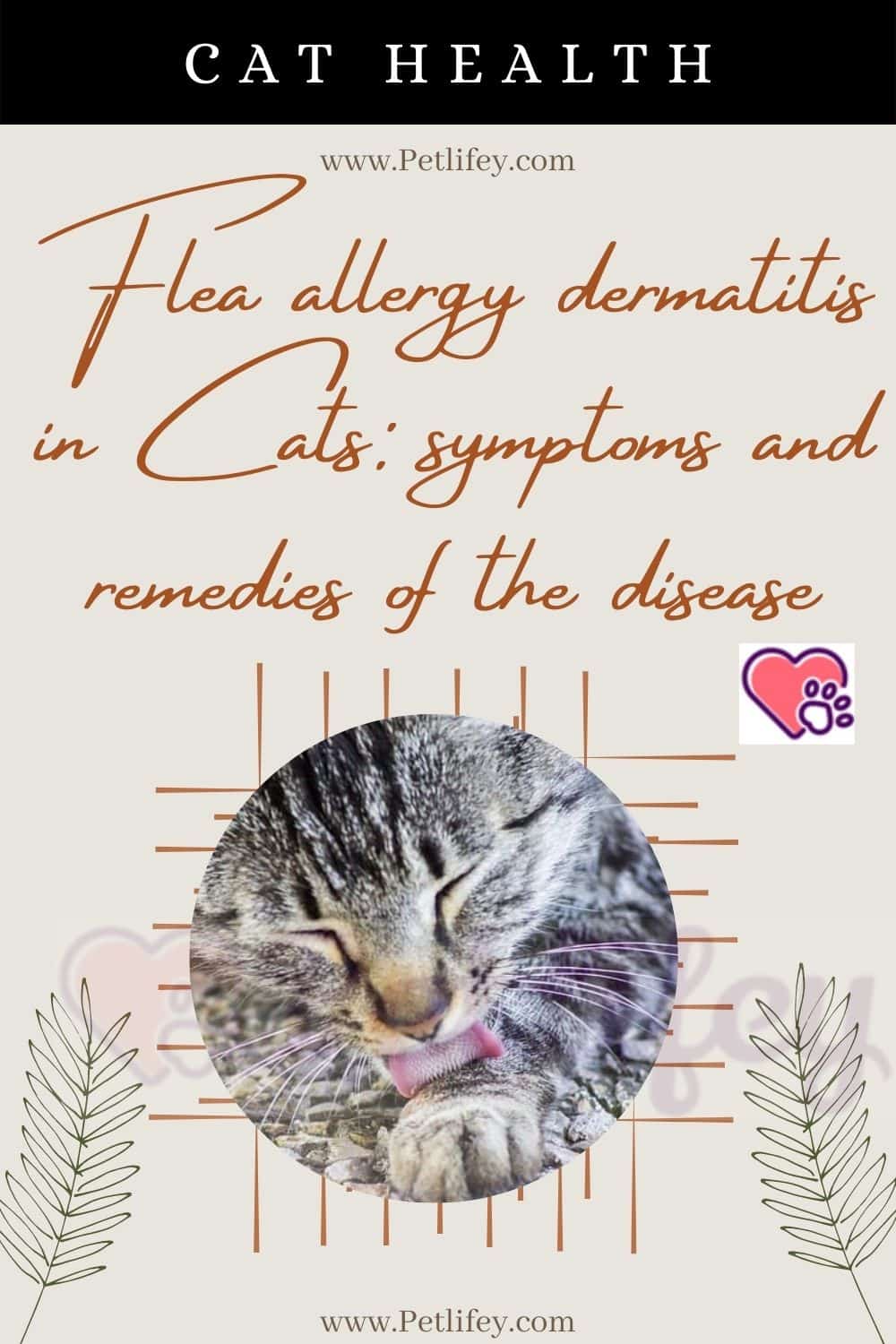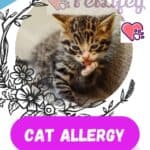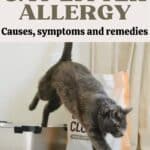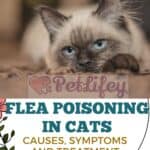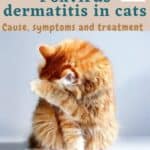Flea Allergy Dermatitis in Cats: Understanding Symptoms and Seeking Effective Remedies
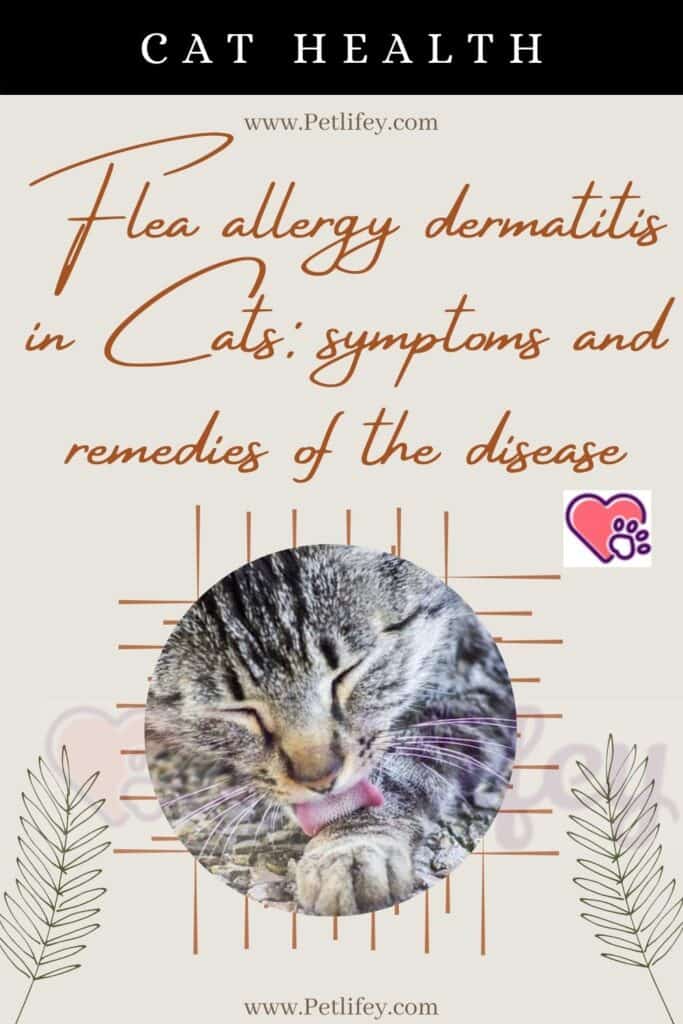
Flea allergy dermatitis, commonly known as FAD, is a frequent condition that affects cats, and it’s something you might encounter as a pet owner. It occurs when your cat is allergic to flea saliva, making even a single flea bite a painful experience. You may notice that your cat is irritated, excessively scratching, or biting at their skin, which could point towards FAD. It is the most common allergic skin disease in cats and a significant cause of allergic reactions in these pets.
Symptoms of FAD in cats can be quite distressing. Aside from the relentless scratching, look for red, inflamed skin, hair loss, and even secondary skin infections caused by the intense scratching and biting. Some cats may develop open wounds or sores from self-trauma. You may not always see fleas on your cat, as it doesn’t require a heavy infestation for a sensitive cat to react—sometimes it’s the hidden few that cause the most trouble.
When it comes to managing flea allergy dermatitis, treating your cat for fleas is the first step. The market offers various prescription and over-the-counter remedies, from topical applications to oral medications that target fleas. But remember, it’s not just about treating your cat; you’ll need to tackle the environment as well to prevent reinfestation. Consult your veterinarian for the most appropriate treatment plan tailored to your cat’s specific needs and health condition.
Understanding Flea Allergy Dermatitis

Flea allergy dermatitis (FAD) is a common and distressing condition for many cats. This section will guide you through the what and why of this allergy, providing clarity on its causes and the role flea saliva plays in triggering it.
Definition and Overview
Flea allergy dermatitis, also known as FAD, is an allergic reaction to flea saliva. When a flea bites a cat, it injects a small amount of saliva into the skin. If your cat has FAD, their immune system overly reacts to proteins or allergens in the flea saliva, which can lead to severe itching and discomfort. It is one of the most prevalent allergies in cats, affecting a significant number of them across various breeds and environments.
Causes and Triggers
FAD is caused directly by the allergenic proteins present in the saliva of fleas. Your cat’s immune system typically protects against pathogens, but with FAD, it mistakenly identifies the harmless proteins as dangerous, triggering an allergic reaction. Several factors can increase a cat’s susceptibility to FAD, including:
- Genetic predisposition to allergies
- Environmental factors that increase flea infestation risks
- Compromised skin barrier function
It is essential to understand that it only takes a few flea bites to trigger a reaction in cats that are hypersensitive to flea saliva. Even if you do not see fleas on your cat, they can still be affected by FAD caused by intermittent flea exposure.
Symptoms of Flea Allergy Dermatitis
Flea Allergy Dermatitis (FAD) in cats is a severe allergic reaction to proteins in flea saliva. When tackling FAD, it’s crucial to recognize the symptoms promptly for effective management of your cat’s condition.
Common Signs
Your cat may exhibit a range of physical indications that it’s suffering from Flea Allergy Dermatitis. These include:
- Intense itching (pruritus) that leads to excessive scratching and grooming
- Red skin lesions or inflamed areas, especially around the head, neck, and base of the tail
- Presence of papules, which are small, raised bumps on the skin
- Hair loss (alopecia) as a result of persistent scratching and licking
- Development of miliary dermatitis, characterized by a multitude of scabs or crusts
Recognizing Flea Bites
Flea bites are typically the catalyst for symptoms in allergic cats. Note the following:
- Flea bites appear as small, red, raised lesions on the skin
- Flea dirt (black specks) in your cat’s fur can be a telltale sign of flea presence
- Cats with FAD might have few visible fleas due to overgrooming that removes fleas and flea dirt
Behavioral Changes
Aside from physical symptoms, behavioral indicators are also telling. Observe if your cat is displaying:
- Increased grooming activity, which can lead to bald patches
- Restlessness or agitation due to the incessant need to scratch
- Avoidance of certain activities or areas due to discomfort from skin irritation
By identifying these symptoms and behavioral changes, you can take swift action in addressing your cat’s Flea Allergy Dermatitis, improving their comfort and quality of life.
Diagnosis of Flea Allergy Dermatitis
When your cat is incessantly scratching, a timely diagnosis by a veterinarian can confirm if flea allergy dermatitis is to blame. Efficient diagnosis leads to prompt and effective treatment.
Veterinary Evaluation
Your veterinarian is pivotal in diagnosing flea allergy dermatitis (FAD). During the examination, they will look for signs of irritation, such as redness, bumps, or hair loss, primarily around the lower back, tailhead, and neck. Although seeing live fleas on your cat can be indicative, absence doesn’t exclude FAD. Your vet may inquire about your cat’s flea control history and will examine the severity of the skin irritation.
Allergy Testing Methods
Intradermal Skin Test: This test involves injecting small amounts of various allergens, including flea antigens, into the skin to observe for reactions.
- Reactions: A positive result typically manifests as a localized swelling at the test site, indicating a flea allergy.
- Limitations: False positives can occur, and some cats may react to the sedatives or the test itself.
Other Diagnostic Approaches:
- Serological Tests: Blood tests checking for antibodies to flea allergens.
- Response to Treatment: Improvement upon administering flea control products can be a confirmation of flea allergy dermatitis.
Treating Flea Allergy Dermatitis
To effectively manage flea allergy dermatitis in your cat, a combination of medications and targeted treatments is essential. Controlling environmental fleas and alleviating your cat’s symptoms are central aspects of the treatment plan.
Medications
When your cat suffers from flea allergy dermatitis, medications play a pivotal role in providing relief. Your veterinarian might prescribe antibiotics to tackle any secondary skin infections caused by excessive scratching. In cases of severe itching and inflammation, steroids like prednisolone may be utilized to offer immediate, albeit temporary, relief. These should always be used under veterinary supervision due to potential side effects.
- Common medications used:
- Antibiotics (for secondary infections)
- Corticosteroids (to reduce inflammation)
- Antihistamines (to lessen allergic reactions)
Topical and Oral Treatments
Topical treatments, such as shampoos or spot-on products containing medicated ingredients, can soothe irritated skin and provide a direct attack on fleas and their larvae. In combination with topical solutions, oral flea treatments are highly effective in preventing further flea infestations. It’s important to treat all pets in the household and the environment to prevent re-infestation.
- Effective treatments:
- Flea control topical treatments
- Oral flea preventatives
Allergen-Specific Therapy
For long-term control and reduction in clinical signs, allergen-specific therapy or allergy shots may be recommended. These are designed to desensitize your cat’s immune system to the allergens that trigger the allergic response. Though this process can take time, it has the potential to provide lasting relief from the recurrent cycles of skin disease.
- Long-term approach:
- Immunotherapy (Allergy shots)
Remember, consistency in applying flea control measures and following veterinary advice is key to managing flea allergy dermatitis effectively.
Management and Prevention
Effective management and prevention of flea allergy dermatitis in cats hinge on thorough flea control and environmental management alongside long-term strategies to maintain a flea-free environment.
Flea Control Measures
You should initiate flea control by applying topical treatments or administering oral medications specifically designed for flea prevention. It’s important to treat all pets in your household, not just the affected cat, to prevent the spread of fleas. Remember to consistently apply these treatments as directed, usually every 30 days, to maintain their efficacy.
- Monthly Topical Treatments: Apply as directed on your cat’s skin.
- Oral Flea Preventatives: Administer monthly or as recommended.
Environmental Management
Environmental management is crucial in the fight against flea infestations. Regularly wash your cat’s bedding and vacuum carpets and furniture to remove flea eggs and larvae.
- Regular Cleaning Routine:
- Vacuum carpets, furniture, and cracks in the floorboards.
- Wash pet bedding in hot water weekly.
- In-House Flea Treatments: Consider environmental sprays or powders that target fleas, ensuring they are safe for use around pets.
Long-Term Strategies
Long-term strategies involve integrating flea prevention into your cat’s routine care. Incorporate regular grooming sessions to check for signs of fleas, such as flea dirt or actual fleas. Remain vigilant with preventative measures year-round, not just during the typical flea season, to avoid an allergic reaction in your cat.
- Regular Grooming: Brush your cat frequently to monitor flea presence.
- Year-Round Prevention: Continue flea control measures all year to reduce the risk of flea allergy flare-ups.
Living with Flea Allergy Dermatitis
Managing Flea Allergy Dermatitis (FAD) in your cats is crucial to reducing discomfort and maintaining their quality of life. The key is to establish effective daily care routines and ensure regular monitoring and follow-up to keep allergies under control.
Daily Care Routines
Your daily care for a cat with FAD should include:
- Parasite Control: Invest in high-quality flea prevention products to minimize exposure. You should apply these treatments regularly according to the product instructions or your veterinarian’s advice.
- Skin Care: Bathe your cat with hypoallergenic or medicated shampoo as recommended by your vet to soothe irritated skin.
- Environmental Cleanliness: Vacuum and clean your home frequently, focusing on areas where your cat spends the most time. This includes bedding, carpets, and furniture.
Remember that even the cleanest homes can harbor fleas, so cleaning is a part of ongoing maintenance rather than a one-time event.
Monitoring and Follow-Up
Keeping track of your cat’s condition is essential:
- Regular Vet Visits: Schedule consistent check-ups with your vet to monitor your cat’s skin condition and adjust treatments as necessary.
- Observation: Be vigilant about changes in your cat’s behavior, such as increased scratching or grooming. These changes could indicate that the FAD is not being effectively managed.
Regular follow-ups and observations can help to promptly address any flare-ups and adapt the management plan for your pet’s allergies, ensuring a happier and more comfortable life for your cat.
Additional Considerations
When addressing flea allergy dermatitis in cats, it’s crucial to be aware of the potential secondary complications, differences in manifestation between cats and dogs, and the latest emerging therapies. Understanding these nuances can be instrumental in managing your cat’s condition effectively.
Secondary Complications
Bacterial infections often follow the intense scratching and skin trauma caused by flea allergy dermatitis. These skin infections can complicate the treatment and healing process. Monitor your cat for signs of infection such as increased redness, swelling, or a foul odor.
- Common Secondary Complications:
- Bacterial skin infections
- Open wounds and sores
- Increased risk of more severe systemic infections
Cats Versus Dogs
Your cat’s response to flea allergy may differ significantly from dogs. Cats typically experience more severe itching at the base of the tail, and unlike dogs, might not have visible flea evidence. Knowing these differences can aid in early detection and treatment for your pet.
- Species-Specific Symptoms:
- Cats: Severe itching, mainly at the base of the tail, less visible fleas
- Dogs: Symptoms might be more widespread, fleas more commonly seen
Emerging Therapies
Research into flea allergy dermatitis is ongoing, presenting new innovations in treatment. These might include novel antipruritic agents or immune-modulating therapies that promise more targeted and effective management of the condition.
- Innovative Treatment Options:
- Immunotherapy
- Novel topical treatments
- Advances in systemic medications
Keep abreast of these advancements, as they may offer new hope for your feline friend’s relief and well-being.
Conclusion
Flea allergy dermatitis (FAD) significantly affects your cat’s skin health and overall well-being. Timely recognition and treatment are crucial. If your cat shows signs of FAD, such as persistent itching, hair loss, or skin lesions, especially around the rump or tail base, it is important to consult a veterinarian.
Key Points to Remember:
- Monitor Skin and Coat: Regularly inspect your cat’s skin for signs of fleas or irritation.
- Effective Flea Control: Use veterinarian-approved flea control products on your cat and in your environment to prevent flea infestations.
- Seek Professional Help: If symptoms persist, a veterinarian can provide medical treatments to alleviate itching and prevent secondary infections.
Adopting a thorough flea management regimen not only improves your cat’s quality of life but also prevents the recurrence of FAD.
Maintaining your cat’s health requires a proactive approach to flea control and a commitment to observing your cat’s behavior for any signs of distress. Your role in managing FAD is instrumental and can lead to a happier, more comfortable life for your feline companion.

